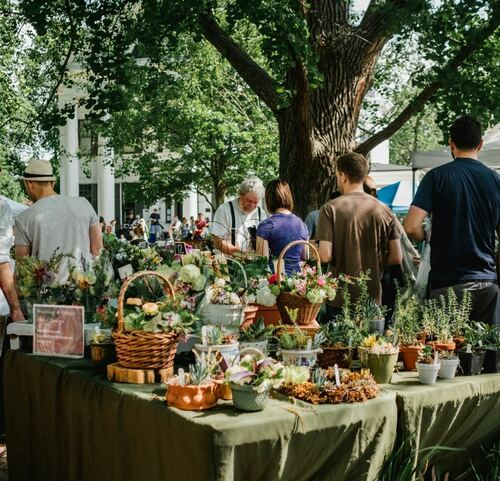Get Off the Couch and Get Under a Canopy (of Trees)!

Introduction
We could not live without trees.
They are indispensable to human life, contributing significantly to our health and well-being. They purify the air by absorbing pollutants and releasing oxygen, making urban environments healthier. Beyond this, trees conserve energy by providing shade, which reduces the need for air conditioning during hot months, and they help retain water in the soil, reducing the risk of water pollution. Trees also play a role in enhancing property values and promoting business activities by creating aesthetically pleasing environments that attract people.
Trees are natural teachers and community builders. They provide spaces for people to gather, fostering a sense of unity and reducing crime rates in urban areas. They also serve as natural markers of the seasons, offering a habitat for various wildlife species, thus supporting biodiversity. These benefits highlight the essential role trees play in both urban and rural settings.
The Healing Benefits of Being Around Trees

A Hand Reaches Up Toward A Grove of Trees - Photo by Aarón Blanco Tejedor on Unsplash
Spending time around trees and green spaces has numerous health benefits. Trees are known to reduce stress levels and boost the immune system. When we breathe in the fresh air around trees, we also inhale phytoncides, which are natural chemicals that trees emit to protect themselves from insects. These chemicals have been found to increase the number of natural killer cells in our bodies, which helps combat tumor and virus-infected cells, potentially reducing the risk of certain cancers.
Additionally, exposure to trees and green spaces can lower blood pressure, improve mood, and enhance the ability to focus. This is particularly beneficial for children with attention deficit disorders and adults in high-stress jobs. Spending time in nature also accelerates recovery from illness or surgery, increases energy levels, and improves sleep patterns. These benefits make a compelling case for incorporating more green spaces into urban planning and encouraging people to spend time outdoors.
Here are some of the health benefits of exposure to trees:
- Reduces stress
- Boosts immune system
- Lowers blood pressure
- Improves mood
- Increases ability to focus
- Hastens recovery from illness or surgery
- Increases energy level
- Improves sleep
Trees in Modern Medicine & Research
Many of today’s pharmaceuticals are developed from trees. The most common treatment for general aches and pains—aspirin—is derived from willow bark; some cancers are treated with drugs created from yews; tea tree oil is used for various skin infections; quinine from cinchona tree bark is the foundation for many antimalarial drugs; circulation is improved with ginkgo.
Doctors now know that along with medication, a patient’s environment plays a very significant role in how a patient recovers. They have found that providing a view of green spaces in recovery wards reduces stress levels and blood pressure.
In 2004, Japan’s National Land Afforestation Promotion Organization conducted an experiment and discovered that a forest stroll had beneficial effects on blood pressure, heart rate, and the immune system. They also found that people who just looked at a forest view for twenty minutes had a 13 percent lower concentration of the stress hormone cortisol. The Japanese have a word for this feeling—shinrin-yoku , or "forest bathing." Even five minutes around trees or in green spaces may improve health—like a free prescription with no negative side effects.
Enhancing Community and Social Well-being

A Community Plant Sale Under City Trees - Photo by Kyle Nieber on Unsplash
Sense of Safety
Though almost 85 percent of the US population lives in suburban and urban areas where access to traditional rural forests is limited, gardens, parks, and street trees make an important difference in the quality of life in these areas. Pockets of green space—often called an urban or community forest—provide a vital resource for daily access to trees.
Researchers at the University of Washington found that residents in a large housing development who lived near trees socialized more with their neighbors, felt much safer, and there were 52 percent fewer crimes. Unlike those living in treeless blocks, they felt emotionally and physically healthier.
Sense of Community
Trees play a significant role in enhancing community and social well-being. Green spaces act as communal areas where people can gather, socialize, and build stronger community ties. This sense of community is crucial for mental health and can lead to safer, more cohesive neighborhoods. Studies have shown that areas with abundant green spaces tend to have lower crime rates and higher levels of social interaction among residents.
Community gardening and urban forestry programs can empower residents to take an active role in improving their environment. These initiatives foster a sense of ownership and pride in the community, leading to more sustainable and well-maintained green spaces. Engaging in these activities also provides educational opportunities, teaching residents about the importance of trees and the environment and encouraging environmental stewardship across generations.
Conclusion

A Crowded City Street Lined with Trees - Photo by Pavlo Luchkovski
As urbanization continues to grow, it is incredibly important to incorporate more green spaces into our cities to ensure a healthy, sustainable future. We are dedicated to promoting the value of trees and providing comprehensive tree care services to enhance the well-being of our community. Embrace the benefits of trees and take a step toward a healthier, greener lifestyle today.
At Arborist Now, we are all about trees, and we are here to provide tree care, to plant trees, to repurpose cut trees, and to inform others about one of nature’s most majestic and important contributions to our amazing planet. Contact us to learn how you can use trees to bolster your health and the health of your community.
Originally published on February 7, 2017.





